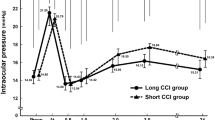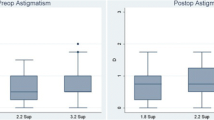Abstract
Purpose
We sought to examine changes in intraocular pressure (IOP) in the immediate period after clear corneal micro-incision cataract surgery (MICS) and after small-incision cataract surgery (SICS).
Methods
Sixty-eight eyes of 34 patients scheduled for coaxial phacoemulsification were randomized into one of two groups: (a) eyes that were to undergo a 2.0-mm MICS, and (b) a 2.65-mm SICS. At the conclusion of surgery, the IOP was adjusted to the range between 15–40 mmHg with stromal hydration. The IOP was measured using a rebound tonometer preoperatively, at the conclusion of surgery, and at 3, 6, 9, 12, and 15 min postoperatively. The Seidel test and anterior segment-optical coherence tomography were performed at 20 min postoperatively.
Results
Mean IOP at the conclusion of surgery was 27.7 ± 4.7 mmHg in the MICS group and 29.7 ± 5.1 mmHg in the SICS group (p = 0.1239). In both groups, mean IOP decreased to the preoperative level within 9 min postoperatively and did not change significantly for up to 15 min. Mean IOP was similar between the MICS and SICS groups throughout the observation period (p ≥ 0.1239). Hypotony (≤10 mmHg), positive Seidel test, and loss of wound coaptation were not detected in all eyes.
Conclusions
After adjusting the IOP to a relatively high level at the conclusion of surgery, the IOP decreased within 9 min and was stable within 15 min without hypotony. The IOP was comparable between eyes after MICS and SICS, and both incisions virtually closed within 20 min postoperatively.



Similar content being viewed by others
References
Cooper BA, Holekamp NM, Bohgian G, Thompson PA. Case-control study of endophthalmitis after cataract surgery comparing scleral tunnel and clear corneal wounds. Am J Ophthalmol. 2003;136:300–5.
Taban M, Behrens A, Newcomb RL, Nobe MY, Saedi G, Sweet PM, et al. Acute endophthalmitis following cataract surgery. Arch Ophthalmol. 2005;123:613–20.
West ES, Behrens A, McDonnell PJ, Tielsch JM, Schein OD. The incidence of endophthalmitis after cataract surgery among the U.S. Medicare population increased between 1994 and 2001. Ophthalmology. 2005;112:1388–94.
Sarayba MA, Taban M, Ignacio TS, Behrens A, McDonnell PJ. Inflow of ocular surface fluid through clear corneal cataract incisions: a laboratory model. Am J Ophthalmol. 2004;138:206–10.
Herretes S, Stark WJ, Pirouzmanesh A, Reyes JM, McDonnell PJ, Behrens A. Inflow of ocular surface fluid into the anterior chamber after phacoemulsification through sutureless corneal wounds. Am J Ophthalmol. 2005;140:737–40.
Chawdhary S, Anand A. Early post-phacoemulsification hypotony as a risk factor for intraocular contamination: in vivo model. J Cataract Refract Surg. 2006;32:609–13.
May W, Castro-Combs J, Camacho W, Wittmann P, Behrens A. Analysis of clear corneal incision integrity in an ex vivo model. J Cataract Refract Surg. 2008;34:1013–8.
Berdahl JP, DeStafeno JJ, Kim T. Corneal wound architecture and integrity after phacoemulsification: evaluation of coaxial, microincision coaxial, and microincision bimanual techniques. J Cataract Refract Surg. 2007;33:510–5.
Behrens A, Stark WJ, Pratzer KA, McDonnell PJ. Dynamics of small-incision clear corneal wounds after phacoemulsification surgery using optical coherence tomography in the early postoperative period. J Refract Surg. 2008;24:46–9.
Calladine D, Packard R. Clear corneal incision architecture in the immediate postoperative period evaluated using optical coherence tomography. J Cataract Refract Surg. 2007;33:1429–35.
Calladine D, Tanner V. Optical coherence tomography of the effects of stromal hydration on clear corneal incision architecture. J Cataract Refract Surg. 2009;35:1367–71.
McDonnell PJ, Taban M, Sarayba M, Rao B, Zhang J, Schiffman R, et al. Dynamic morphology of clear corneal cataract incisions. Ophthalmology. 2003;110:2342–8.
Ki-I Y, Yamashita T, Uemura A, Sakamoto T. Long-term intraocular pressure changes after combined phacoemulsification, intraocular lens implantation, and vitrectomy. Jpn J Ophthalmol. 2013;57:57–62.
Shingleton BJ, Wadhwani RA, O’Donoghue MW, Baylus S, Hoey H. Evaluation of intraocular pressure in the immediate period after phacoemulsification. J Cataract Refract Surg. 2001;27:524–7.
Rhee DJ, Derano VA, Connolly BP, Blecher MH. Intraocular pressure trends after supranormal pressurization to aid closure of sutureless cataract wounds. J Cataract Refract Surg. 1999;25:546–9.
Hayashi K, Yoshida M, Manabe S, Yoshimura K. Effect of high pressurization versus normal pressurization on changes in intraocular pressure immediately after celar corneal cataract surgery. J Cataract Refract Surg. 2014;40:87–94.
Olson RJ. Clinical experience with 21-gauge manual microphacoemulsification using Sovereign WhiteStar technology in eyes with dense cataract. J Cataract Refract Surg. 2004;30:168–72.
Cavallini GM, Campi L, Masini C, Pelloni S, Pupino A. Bimanual microphacoemulsification versus coaxial miniphacoemulsification: prospective study. J Cataract Refract Surg. 2007;33:387–92.
Dosso AA, Cottet L, Burgener ND, Di Nardo S. Outcomes of coaxial microincision cataract surgery versus conventional coaxial cataract surgery. J Cataract Refract Surg. 2008;34:284–8.
Alió J, Rodriquez-Prats JL, Galal A, Ramzy M. Outcomes of microincision cataract surgery versus coaxial phacoemulsification. Ophthalmology. 2005;112:1997–2003.
Kurz S, Krummenauer F, Gabriel P, Pfeiffer N, Dick HB. Biaxial microincision versus coaxial small-incision clear cornea cataract surgery. Ophthalmology. 2006;113:1818–26.
Yao K, Tang X, Ye P. Corneal astigmatism, high order aberrations, and optical quality after cataract surgery: microincision versus small incision. J Refract Surg. 2006;22:1079–82.
Hayashi K, Yoshida M, Hayashi H. Postoperative corneal shape changes: microincision versus small-incision coaxial cataract surgery. J Cataract Refract Surg. 2009;35:233–9.
Cheng B, Liu Y, Liu Y, Xie BB, Xi L, Yang Y. Early changes in morphology and intraocular pressure by size of clear corneal incision. Cornea. 2011;30:634–40.
Kontia AI. A new induction-based impact method for measuring intraocular pressure. Acta Ophthalmol Scand. 2000;78:142–5.
Brusini P, Salvetat ML, Zeppieri M, Tosoni C, Parisi L. Comparison of ICare tonometer with Goldmann applanation tonometer in glaucoma patients. J Glaucoma. 2006;15:213–7.
Nakamura M, Darhad U, Tatsumi Y, Fujioka M, Kusuhara A, Maeda H, Negi A. Agreement of rebound tonometer in measuring intraocular pressure with three types of applanation tonometers. Am J Ophthalmol. 2006;142:332–4.
Davies LN, Barlett H, Mallen EAH, Wolffsohn JS. Clinical evaluation of rebound tonometer. Acta Ophthalmol Scand. 2006;84:206–9.
Sahin A, Basmak H, Niyaz L, Yildirim N. Reproducibility and tolerability of the ICare rebound tonometer in school children. J Glaucoma. 2007;16:185–8.
Pakrou N, Gray T, Mills R, Landers J, Craig J. Clinical comparison of the Icare tonometer and Goldmann applanation tonometry. J Glaucoma. 2008;17:43–7.
Scuderi GL, Cascone NC, Regine F, Perdicchi A, Cerulli A, Recupero SM. Validity and limits of the rebound tonometer (ICare®): clinical study. Eur J Ophthalmol. 2011;21:251–7.
Acknowledgments
The authors thank SciTechEdit International (Highlands Ranch, CL, USA) for editorial assistance and Masahiro Toda, PhD (CMIC Co., Ltd, Tokyo, Japan) for statistical assistance.
Conflicts of interest
K. Hayashi, Grants (Alcon Japan, Santen), Speakers bureau fee (Alcon); M. Yoshida, Grants (Alcon Japan, Santen), Speakers bureau fee (Alcon); K. Yoshimura, Grants (Alcon Japan, Santen).
Author information
Authors and Affiliations
Corresponding author
About this article
Cite this article
Hayashi, K., Yoshida, M. & Yoshimura, K. Immediate changes in intraocular pressure after clear corneal micro-incision versus small-incision cataract surgery. Jpn J Ophthalmol 58, 402–408 (2014). https://doi.org/10.1007/s10384-014-0331-7
Received:
Accepted:
Published:
Issue Date:
DOI: https://doi.org/10.1007/s10384-014-0331-7




